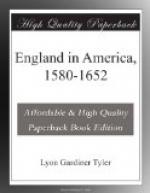The Plymouth settlers were destined to be dispossessed, not by the Dutch, but by their own countrymen. The people of Massachusetts were now fully aroused, and the news that came to Boston in the summer of 1634 that the small-pox had practically destroyed the Indians on the river increased “the hankering” after the coveted territory.[41] The people of Watertown, Dorchester, and Newtown (Cambridge) had long been restless under the Massachusetts authority, and were anxious for a change. Dorchester was the residence of Captain Israel Stoughton, and Watertown the residence of Richard Brown and John Oldham, all three of whom had been under the ban of the orthodox Puritan church. At Watertown also had sprung up the first decided opposition to the aristocratic claim of the court of assistants to lay taxes on the people. As for Newtown (now Cambridge), its inhabitants could not forget that, though selected in the first instance as the capital of the colony, it had afterwards been discarded for the town of Boston.
In all three towns there was a pressure for arable lands and more or less jealousy among the ministers. Some dissatisfaction also with the requirement in Massachusetts of church-membership for the suffrage may have been among the motives for seeking a new home. At the head of the movement was the Rev. Thomas Hooker, a graduate of Emmanuel College, Cambridge, who had lived in Holland, and while there had imbibed a greater share of liberality than was to be found among most of the clergy of Massachusetts. Cotton declared that democracy was “no fit government either for church or commonwealth,” and the majority of the ministers agreed with him. Winthrop defended his view in a letter to Hooker on the ground that “the best part is always the least, and of that best part the wiser part is always the lesser.” But Hooker replied that “in matters which concern the common good a general council, chosen by all, to transact business which concerns all, I conceive most suitable to rule and most safe for the relief of the whole.”
Hooker arrived in the colony in September, 1633,[42] and in May, 1634, at the first annual general court after his arrival, his congregation at Newtown petitioned to be permitted to move to some other quarters within the bounds of Massachusetts.[43] The application was granted, and messengers were sent to Agawam and Merrimac to look for a suitable location.[44] After this, when the epidemic on the Connecticut became known, a petition to be permitted to move out of the Massachusetts jurisdiction was presented to the general court in September, 1634. This raised a serious debate, and though there can be little doubt that Winthrop and the other leaders in Massachusetts shrewdly cherished the idea of pre-empting in some way the trade of the Connecticut, against both the Plymouth people and the Dutch, an emigration such as was proposed appeared too much like a desertion. The fear of the appointment by the crown of a governor-general for New England was at its height, and so the application, though it met with favor from the majority of the deputies, was rejected by the court of assistants.[45]




